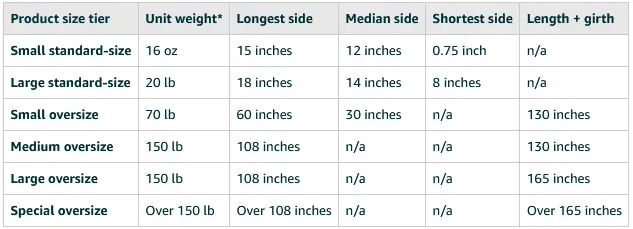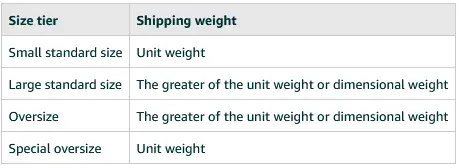Fulfillment Fee Basics
The Amazon FBA fulfillment fee, often dubbed the "pick and pack" fee, is a per-unit charge covering the handling and shipping costs for items sent to customers. This fee is not a one-size-fits-all; it varies based on the product category, size, and weight.
Dive into the specifics, as rates may differ for products enrolled in Multi-Channel Fulfillment or those eligible for Low-Price FBA rates. Tailor your understanding to your product's unique characteristics.
Time of Charge and FBA Fee Structure
Remember, fulfillment fees kick in when the buyer's order is shipped, not at the point of listing or sale. Understand that the fee structure is per unit fulfilled, with rates dictated by product type, size tier, and shipping weight.
Holiday Peak Fulfillment Fee
Be aware of the Holiday Peak Fulfillment Fee from October 15, 2023, to January 14, 2024. Exceptions exist for items priced under $10, where Low-Price FBA rates apply.
Calculating Fees: Product Size Tiers and Shipping Weight
Delve into the nuances of your product's size tier and the art of calculating shipping weight. These factors play a pivotal role in determining the fees you'll encounter. Now, let's dissect the values used to calculate fees, adding a layer of depth to your understanding.
Determine Product Size Tiers - Size Matters
Size tiers categorize items based on unit weight, product dimensions, and dimensional weight. Determine your product's size tier using precise measurements or refer to the Monthly Storage Fees report for historical insights.Begin by measuring the volume and dimensions of your item. This includes noting the unit weight and dimensional weight. Armed with these values, refer to the table below to determine your product size tier. Look for the row that aligns with the weight and dimensions of your item.

Determine Shipping Weight - The Fee Game Changer
Shipping weight, derived from unit weight or dimensional weight, is a critical factor in fee calculations. Master the skill of determining your product's shipping weight for accurate fee predictions. Let's unravel the art of determining your product's shipping weight, ensuring you're always one step ahead in the fee game.
- Measure Product Volume and Dimensions: Begin by determining the volume and dimensions of your item.
- Identify Product Size Tier: Know the size tier of your item, obtained from the product size tier determination.
- Determine Unit Weight: Find the unit weight of your item, a measure of how much it weighs when packaged.
- Calculate Dimensional Weight: If applicable, calculate the dimensional weight and understand whether it will be used in fee calculations.
- Refer to the Shipping Weight Table: Use the table below to determine the shipping weight of your item.

Dimensional Weight - When Size Takes the Lead
In certain cases, it's not just about the weight; it's about the space your product occupies. Learn how to calculate dimensional weight, a key player in fee variations.
Dimensional weight is a calculated metric derived from your item package's dimensions. The formula involves multiplying the package's overall length, width, and height, then dividing by 139. This ensures a fair assessment of shipping costs based on the space your product occupies. Dimensional Weight = (Length x Width x Height) / 139. For oversize items, a minimum width and height of 2 inches are assumed.
Determine Standard-Size, Oversize, and Special Oversize with the following category levels:
Small Standard-Size Item Criteria:
- Unit weight is less than or equal to 1 pound.
- Longest side (length) is less than or equal to 15 inches.
- Median side (width) is less than or equal to 12 inches.
- Shortest side (height) is less than or equal to 0.75 inches.
Large Standard-Size Item Criteria:
- Unit weight is less than or equal to 20 pounds.
- Longest side (length) is less than or equal to 18 inches.
- Median side (width) is less than or equal to 14 inches.
- Shortest side (height) is less than or equal to 8 inches.
Oversize Criteria:
- Items not meeting the standard-size criteria are considered oversize.
- Products that require special delivery options due to size, weight, handling requirements, or other restrictions.
- Criteria include unit weight over 150 pounds, longest side over 108 inches, or girth plus length over 165 inches.
Fee Categorie - Unlocking Rate Variations
Fee categories act as gatekeepers, determining which rates apply to your product. Unlock the potential savings by understanding the intricacies of fee categories for your specific product. Fee categories serve as the guiding force, determining the rates applicable to specific fee types for your product. It's important to note that your product's fee category may not align with its category on the Amazon retail site. The designated fee category plays a pivotal role in establishing the referral fee rate and may have a ripple effect on other associated fees.
It's important to note that your product's fee category may not align with its category on the Amazon Seller Central site. The designated fee category plays a pivotal role in establishing the referral fee rate and may have a ripple effect on other associated fees.
Elevating Your FBA Strategy with AmzMonitor's FBA Calculator
In the intricate world of Amazon FBA fees, mastering the game is about more than just understanding the basics—it's about leveraging powerful tools. Among these tools, AmzMonitor's FBA Calculator stands out, offering a strategic edge in optimizing your FBA operations.
Unveiling AmzMonitor's FBA Calculator
AmzMonitor's FBA Calculator goes beyond standard tools, providing a comprehensive view of Amazon FBA fees and profitability. It offers two user-friendly options, allowing you to tailor your approach:
- ASIN and Marketplace Convenience: Effortlessly retrieve product details by simply inputting the ASIN and selecting the marketplace. This streamlined process ensures quick and accurate fee calculations, saving you time and effort.
- Custom Precision with Manual Entry: For those who prefer a hands-on approach, AmzMonitor's FBA Calculator allows manual entry of custom product details. This precision ensures that your calculations align perfectly with your unique product characteristics.
Why Choose AmzMonitor?
- Comprehensive Insights: Beyond the basics, AmzMonitor's tool provides nuanced insights, aligning with the mastery of product size tiers, shipping weight, dimensional weight, and fee categories.
- Time-Efficient: With automated ASIN and Marketplace retrieval, or the manual entry option, AmzMonitor ensures a seamless and time-efficient fee calculation process.
- Strategic Decision-Making: Armed with detailed fee breakdowns, you can make informed decisions, optimizing pricing and profitability in the competitive Amazon marketplace.
Mastering the FBA Fee Game
As you navigate the complexities of FBA, AmzMonitor's FBA Calculator becomes your trusted companion. Dive into the details, unlock savings, and refine your pricing strategy for enhanced profitability. The more you know, coupled with the precision of AmzMonitor, the stronger your position in the competitive FBA landscape. Happy calculating!


